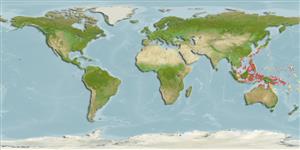Actinopterygii (ray-finned fishes) >
Perciformes (Perch-likes) >
Gobiidae (Gobies) > Gobiinae
Etymology: Acentrogobius: Greek, a = without + Greek, kentron = sting + Latin gobius = gudgeon (Ref. 45335).
Environment / Climate / Range
Ecology
Marine; brackish; demersal; depth range 1 - 4 m (Ref. 90102). Tropical, preferred ?
Western Pacific: Ryukyu Islands, Philippines, Indonesia (Ref. 559) and Papua New Guinea (Ref. 6771).
Size / Weight / Age
Maturity: Lm ? range ? - ? cm
Max length : 3.3 cm SL male/unsexed; (Ref. 7050)
Dorsal
spines
(total): 6 - 7;
Dorsal
soft rays
(total): 9;
Anal
spines: 1;
Anal
soft rays: 9. Characterized by pale grey body color with brown band below eye; gill cover with dark brown streak and blue margin; head and upper half of body with irregular, brown spots and blotches; chain-link pattern at level of upper pectoral fin base to caudal base, composed of five rectangular blotches between two brown stripes, with 2-3 blue spots between each blotch; first three spines of first dorsal usually have filamentous tips; lanceolate caudal fin;, longer than head; longitudinal scale series 28-30; head without scales; ctenoid body scales; depth of body 5.3-5.5 in SL (Ref. 90102).
Inhabits silty sand and mud bottoms, usually near mouth of streams, occasionally near reefs in 1-4 m (Ref. 90102).
Life cycle and mating behavior
Maturity | Reproduction | Spawning | Eggs | Fecundity | Larvae
Masuda, H., K. Amaoka, C. Araga, T. Uyeno and T. Yoshino, 1984. The fishes of the Japanese Archipelago. Vol. 1. Tokai University Press, Tokyo, Japan. 437 p. (text). (Ref. 559)
IUCN Red List Status (Ref. 115185)
CITES (Ref. 94142)
Not Evaluated
Threat to humans
Harmless
Human uses
More information
Common namesSynonymsMetabolismPredatorsEcotoxicologyReproductionMaturitySpawningFecundityEggsEgg development
ReferencesAquacultureAquaculture profileStrainsGeneticsAllele frequenciesHeritabilityDiseasesProcessingMass conversion
Tools
Special reports
Download XML
Internet sources
